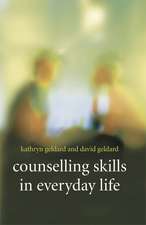Concepts, Results, and Applications
Editat de E. Klingeren Limba Engleză Paperback – 21 ian 2013
Preț: 380.61 lei
Preț vechi: 400.65 lei
-5% Nou
Puncte Express: 571
Preț estimativ în valută:
72.84€ • 75.76$ • 60.13£
72.84€ • 75.76$ • 60.13£
Carte tipărită la comandă
Livrare economică 14-28 aprilie
Preluare comenzi: 021 569.72.76
Specificații
ISBN-13: 9781468439762
ISBN-10: 1468439766
Pagini: 412
Ilustrații: IX, 397 p. 10 illus.
Dimensiuni: 178 x 254 x 22 mm
Greutate: 0.71 kg
Ediția:Softcover reprint of the original 1st ed. 1981
Editura: Springer Us
Colecția Springer
Locul publicării:New York, NY, United States
ISBN-10: 1468439766
Pagini: 412
Ilustrații: IX, 397 p. 10 illus.
Dimensiuni: 178 x 254 x 22 mm
Greutate: 0.71 kg
Ediția:Softcover reprint of the original 1st ed. 1981
Editura: Springer Us
Colecția Springer
Locul publicării:New York, NY, United States
Public țintă
ResearchCuprins
I. Concepts of Imagery.- The Central Place of Imagery in Human Functioning.- Imaginative Play as the Precursor of Adult Imagery and Fantasy.- Developmental Aspects of Mental Imagery: A Theory of Thematic Dissonance.- Life-Sustaining Systems and Consciousness.- A Philosophical Critique of Piaget’s View of Images as Interiorized Actions.- Images, Propositions, and Natural Signs.- II. Measurement of Imagery.- Imagery Measurement in Clinical Settings: Matching the Method to the Question.- Imagery Assessment through Content Analysis.- III. Hypnosis and Imagery.- Hypnotic Responding: Automatic Dissociation or Situation-Relevant Cognizing?.- Vivid Fantasy and Hallucinatory Abilities in the Life Histories of Excellent Hypnotic Subjects (“Somnambules”): Preliminary Report with Female Subjects.- IV. Synaesthesia.- A Comparison of Synesthetes and Nonsynesthetes.- Chromesthetic Responses to the Music of G. F. Handel.- V. Imagery and Cognitive Processes.- Brain Hemisphericity and Response to the Imaginal Processes Inventory.- Imagery, Incubation, and Right Hemispheric Learning Style as Related to Divergent Thinking.- The Interactive Effects of Imagery Learning Strategy and Originality on Learning and Long-Term Retention.- Mental Imagery and Creativity.- Self-Consciousness as a Component and Correlate of Focusing Ability.- Mental Imagery: A Memory Aid for the Older Adult?.- Training Spatial Ability.- VI. Imagery and Clinical Treatment.- A Multiple Component Model of Clinical Imagery.- The Role of Mental Events in Behavior Therapy.- The Psychologist’s Imagination and Sexual Imagery.- Using Death Imagery to Induce Proper Grieving: An Emotive-Reconstructive Approach.- Interpersonal Conflict and Mental Imagery.- The Application of Humorous Imagery Situations in Psychotherapy:Case Illustrations.- Covert Modeling in the Context of Storytelling: Observational Learning in Therapy with Children.- Kinetic Imagery in Movement Psychotherapy.- Bridging through Imagery: An Integration of the Selves through Art Therapy, a Visual Dialogue.- An Art Therapy Approach to the Drug Abuser, Correlating Behavioral, Narcissistic, and Laterality Theory.- Contributors.














